Research on Cerro Mejía has trained many students in archaeology. Since 2008 a formal Archaeological Field School has been offered to students of the University of Illinois Chicago, Northwestern University, Ripon College, and many others. The program has now shifted to The University of North Carolina Greensboro and is offered through UNCG’s International Program Center.
The Cerro Mejía Field School offers students experience in excavation, mapping, artifact analysis, and local culture.
by Emma H. Thomas
Settling In
Students of the 2011 excavations arrived in the large Peruvian city of Arequipa on June 16, 2011 and then took a bus ride south to the smaller city of Moquegua. Moquegua, a thirty minute combi ride from the archaeological site of Cerro Mejía, was the home of the field students for the duration of their five week experience. On the students’ second day in Peru, Dr. Donna Nash presented a tour of Museo Contisuyo, the local Museum that partners with Dr. Nash for her research in the area. After learning about Andean chronology and regional history, students were privileged to hear a lecture about Andean ecology and society by the University of Florida’s Distinguished Professor, Dr. Michael Moseley.
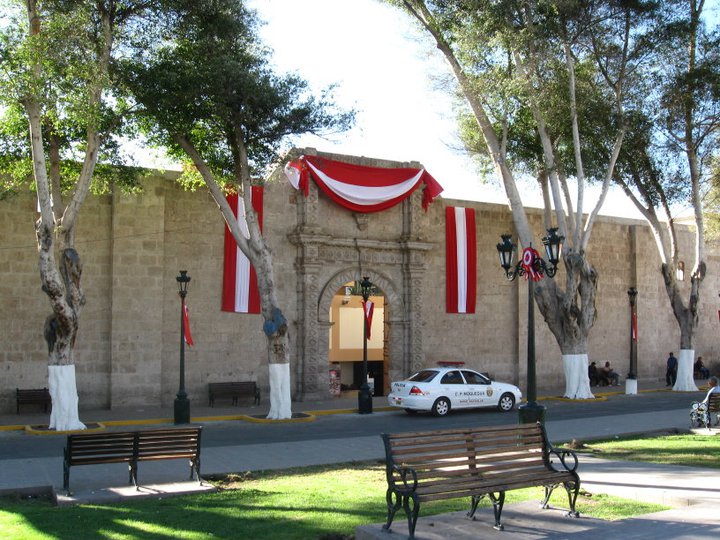
A view of Museo Contisuyo from the Plaza de Armas. The museum is decorated for July 28, the much-celebrated Peruvian Independence day. Museo Contisuyo is a five minute walk from the students’ field house down Calle Moquegua.
Hiking Up & Digging Down
On June 18, students rose early to begin their work in the field! Students boarded the combi to Cerro Mejía at 7am and after an uphill hike, arrived on site around 8am. Each day they completed various fieldwork tasks until 3:30pm and then continued their day with laboratory analysis of uncovered artifacts until 6:30pm. Saturdays were also spent completing educational workshops and laboratory analysis. Students’ learning objectives were organized by weeks, with particular milestone assignments completed each week to demonstrate a growing archaeological competence.
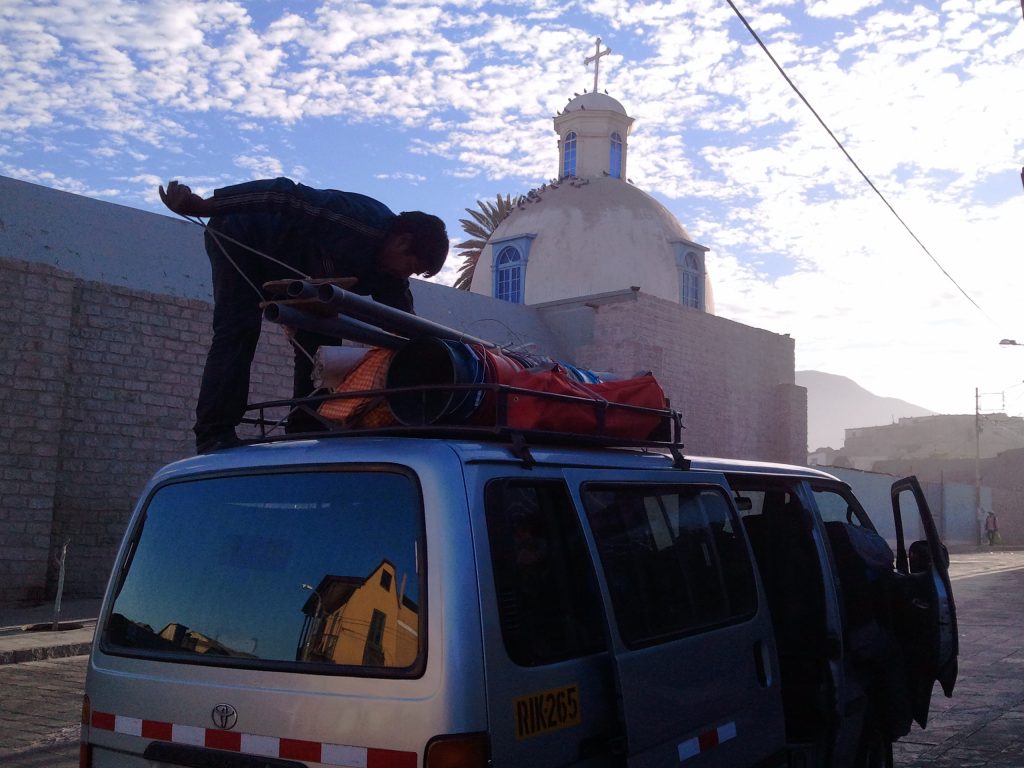
One of the two combis that the students and staff rode in each day to Cerro Mejía. The combi driver is strapping the field equipment to the top of the vehicle to make room for more passengers (i.e. field students!).
Learning the Tools of the Trade
During the first week of the Field School, students learned to set up an excavation grid using tapes and a compass, and were introduced to three significant mapping tools: compass and tape, total station, and differential GPS. By the end of Week 1 students had mastered plan-view drawing and the recording of elevations using datums and an automatic level. Students were also introduced to the proper handling, cleaning, packaging, and labeling of archaeological artifacts. Saturday’s workshop was led by Teaching Assistant Emily Baca, and introduced students to Ceramic Analysis. During lab time they performed assigned tasks and processed different materials arriving from Cerro Mejía excavations. That weekend, excited students climbed to the top of Cerro Baúl with Dr. Nash leading the way! They were given a tour of the site and gained insights into the life ways of the Wari who lived on top such an impressive mesa.
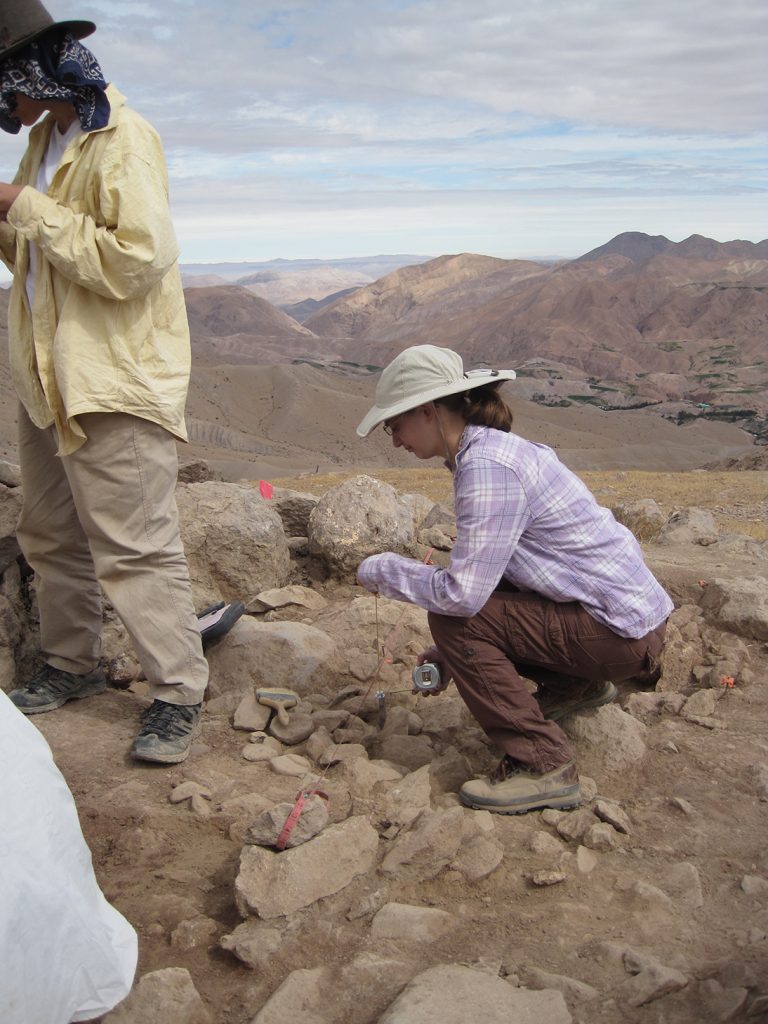
UNCG Student Megan Allen uses a plum-bob and a hand-tape to plot out points with her drawing partner.
Smooth Moves—Understanding Excavation Techniques
The second week of excavations, as students were becoming used to the strenuous hike up to the site, their task was to observe excavation techniques and acquire skills necessary to properly treat artifacts in the field. Students were assigned to a local archaeological technician, and with this technician they screened the recovered soil and learned how to label all of the artifact bags which held the collected materials. Students also carefully observed their partnered archaeological technician during the excavation of a context and wrote notes in their field notebook. They were asked to pay close attention to the technician’s excavation techniques, the characteristics of the soil, artifacts that may have been uncovered, and any other possibly important details. Once the context was completely excavated the students filled out a standard field form. By the end of Week 2, students had accomplished competence in screening and bag labeling as well as the successful completion of a Standard Field Form based on observation.
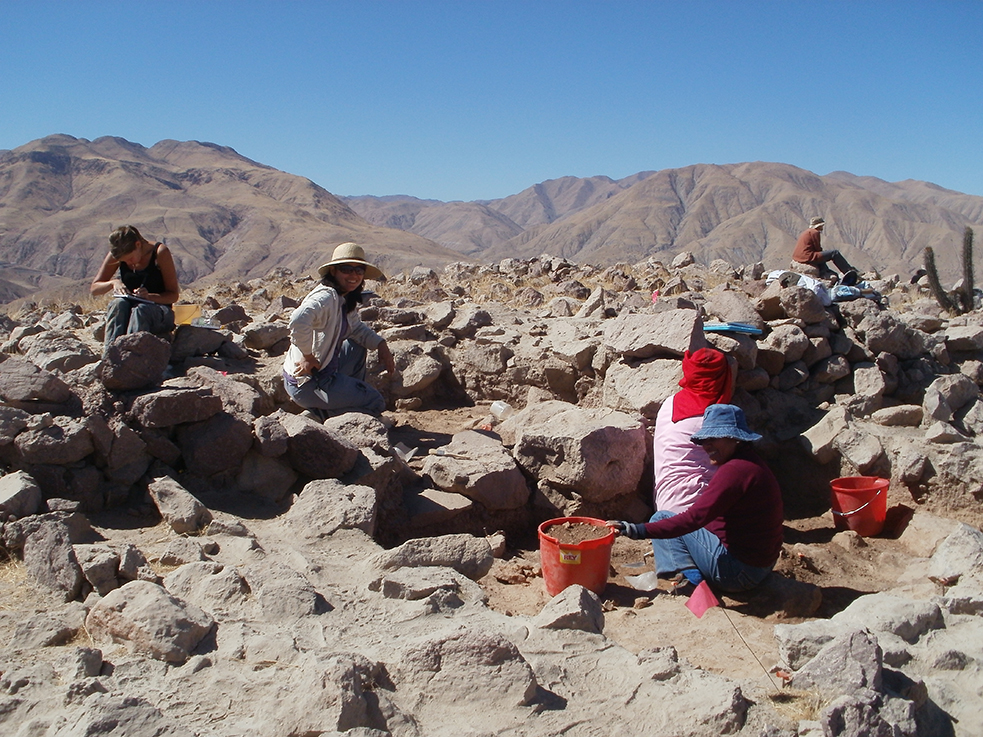
A typical scene atop Cerro Mejía: archaeological technicians are busy excavating in Teaching Assistant Emily Baca’s Unit (second from left) and University of Illinois—Chicago student Alexis Ochalla (far left) writes notes based on her observations of the excavation process.
Lithics in the Lab & the Ingenious Inka
Saturday’s workshop with Dr. Donna Nash and Teaching Assistant David Reid introduced students to Lithics Analysis and they learned how to record data about flakes and cores using materials they knapped themselves.
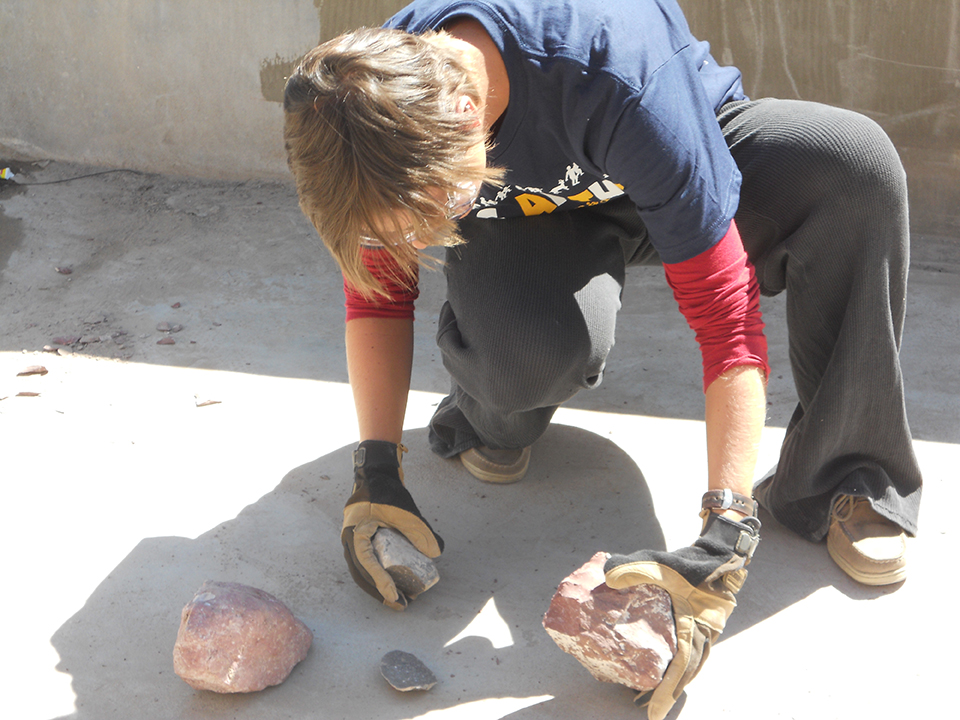
UNCG student Kristen Welch pounds away at the core with her hammerstone, producing a large flake!
The second excursion of the field school included a visit to the high-altitude Inka site of Camata Tambo (AD1480-1530) which included a detailed tour of the site’s architecture and the nearby farming terraces. The students learned about the history of the tambo and the archaeological artifacts that were found at the site during a lecture entitled: “The Inka Empire: A Model for Understanding the Wari Empire” by Ph.D. Candidate from the University of Illinois-Chicago and the project’s Peruvian Co-director, Sofía Chacaltana Cortez.

The field students pose on old farming terraces near the site of Camata Tambo after exploring the surrounding area.
Diggin’ It—When the Trowel Meets the Dirt
During the third week of the field school, students were allowed to excavate! Students received demonstrations from Dr. Nash or the Teaching Assistants and were positioned adjacent to a skilled archaeological technician for their first experience digging in the units. They were responsible for taking appropriate samples such as pH and Munsell (color) samples and for screening their own soil, labeling their own artifact and sample bags, and taking notes in their notebook about what they encountered while excavating. By the end of this week, students were expected to exhibit competency in excavation techniques, and were graded on their improvement and understanding.

UNCG student Jenn Grenier carefully excavates in Unit 136 G1, hoping for some cool finds
beneath the large ceremonial plaza.
Bones & the Beach
Saturday’s workshop topic was the Basics of Faunal Analysis, and Dr. Susan deFrance (Associate Professor, University of Florida), assisted by Teaching Assistant Emily Schach led the students in an educational workshop about methods for identifying mammal, bird, and fish bones using archaeological and comparative specimens. This weekend’s excursion took the students on a bus ride to the foggy and chilly coast of Peru; to the port city of Ilo. Here students were given a detailed tour of Quebrada Tacahuay and learned about early coastal foragers and logistical collectors at this site from Dr. deFrance. Students were then given the chance to explore the rocky beach and discover the variety of bone and shell pieces washed up by the tides. The excursion ended with a large and delicious family-style ceviche lunch, which left all students stuffed to the brim and sleepy for the combi ride back to Moquegua.
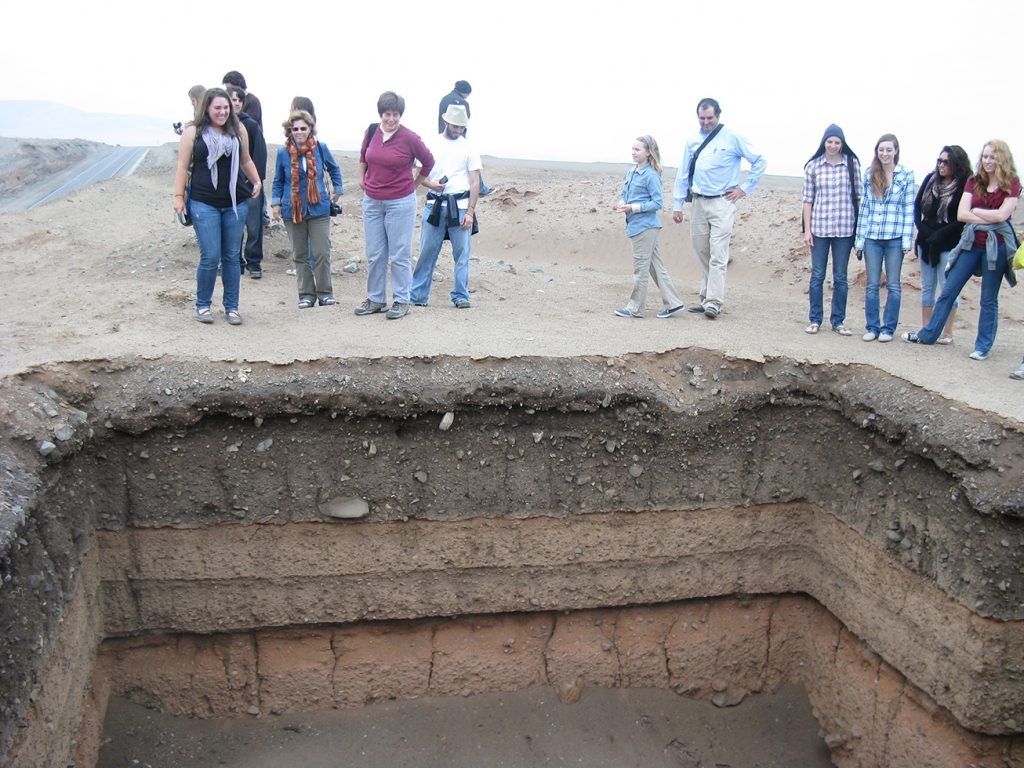
Students explore an archaeological site near the coastal city of Ilo after learning about the region from Dr. Susan deFrance (third from the left).
What an Attractive Profile You Have (Drawn)!
Week Four of being in Peru, students were assigned one of the excavation profiles to draw, a project which developed their understanding of stratigraphy and context. They drew and photographed the unit’s profile, utilizing their knowledge of the auto-level, plum bob, line-level, and hand tape measurer. They were also expected to take Munsell samples of each soil layer and note the texture and compaction of each layer. Students also took radiocarbon samples if they happened to be present within their profile. Upon acceptable completion of their profile drawing, students were assigned a quadricula, capa, or feature to excavate and document for their final field school project.
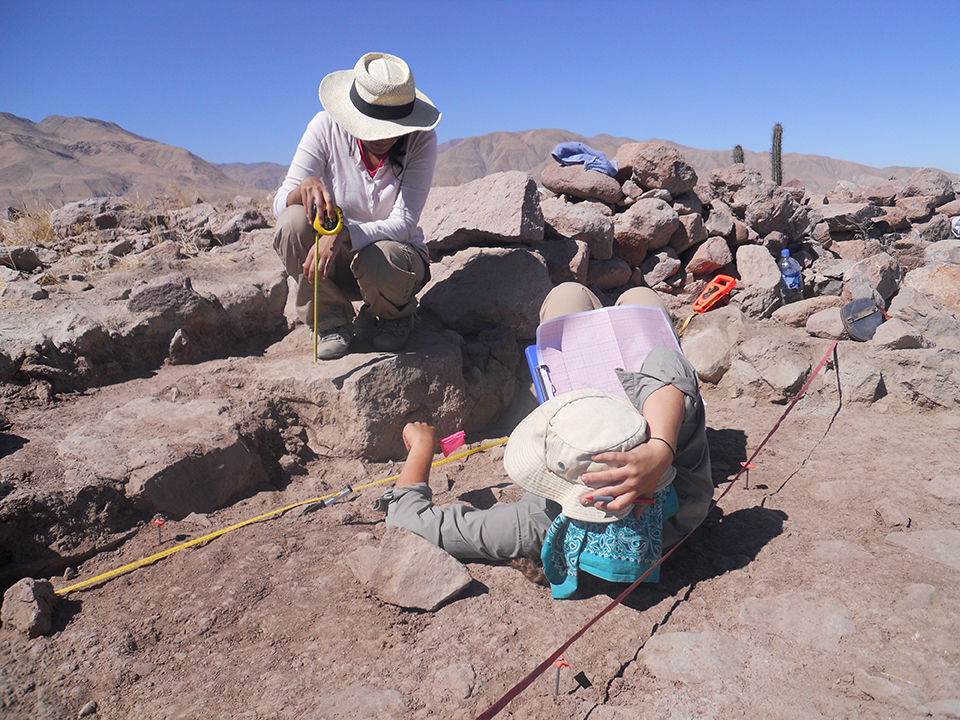
UNCG student Emma Thomas lays in unit 136 G4 to get a momentary view of the rock she is drawing for her profile drawing assignment. University of Illinois—Chicago student Navya Sampson helps her out by measuring points.
Hunting for Carbon & Exploring a Temple
The topic of the fourth Saturday lab was an introduction to Botanical Analysis led by Teaching Assistant Matthew Biwer, and students learned how to sort through float samples from Cerro Mejía to discover small particles of carbon or other ancient botanical remains. The week’s excursion first took the students to the Middle Moquegua Valley and an Omo temple. The students were privileged to be given a once-in-a-lifetime private tour of the recently excavated Omo temple by fellow archaeologist Dr. Paul Goldstein (University of California at San Diego). After the tour their day continued with a visit to an Estuquiña Village and a Colonial Winery to try world famous Peruvian Pisco.
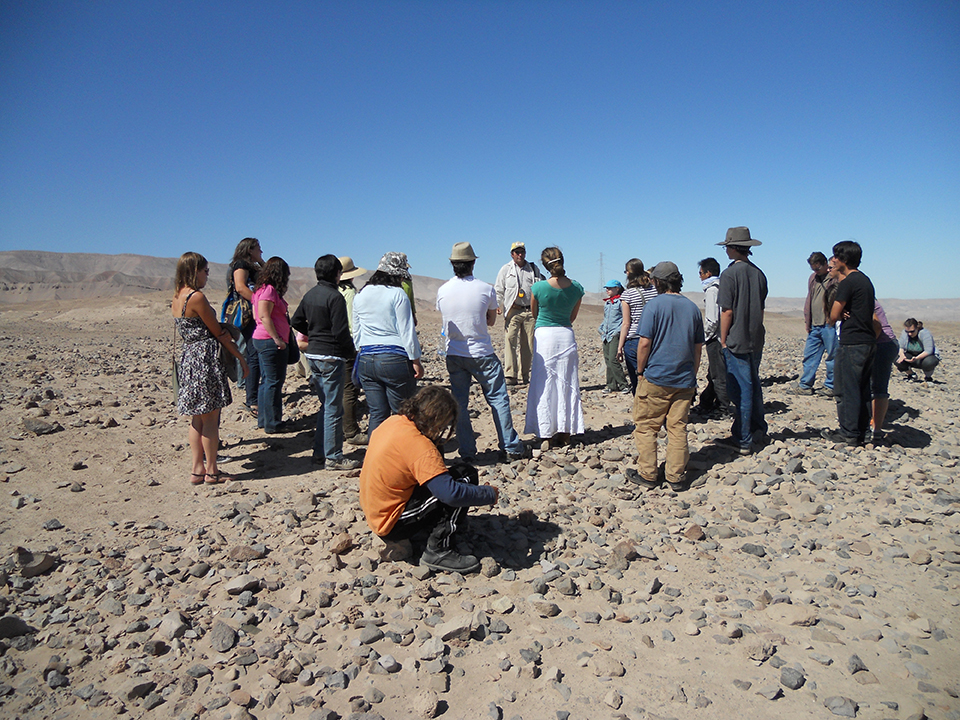
Field students and Teaching Assistants listen to Dr. Paul Goldstein, University of California at San Diego (center, facing camera), explain the history of the region before getting a Class A tour of the Omo Temple. University of Illinois—Chicago student Adrian Zabek (squatting in foreground) looks around while listening, hoping to spot an uncovered artifact.
Coming to a Close—Final Projects in the Field
The fifth and final week of the field school brought an increase in the students’ responsibilities in the field. After being assigned the feature, quad, or capa to excavate for their final project, they were asked to propose an excavation strategy for the assignment based on project protocols and the excavation experience they acquired. Once their unit supervisor approved the strategy, the students were in charge of the excavation and documentation of their assigned context. They were responsible for keeping notes, labeling bags, and completing the standard field form, which required drawing and photography. Students had the help of rotating archaeological technicians to assist them with screening, excavation, and drawing as needed. Their lab work for the week focused on processing and analyzing the materials recovered from their assigned context. Once their excavation was complete, they were asked to write a three to five page essay describing their excavation methodology, explaining why it was devised, and evaluating if it was a successful strategy. Students were also asked to comment on what they learned and how they might excavate a similar feature differently in the future.
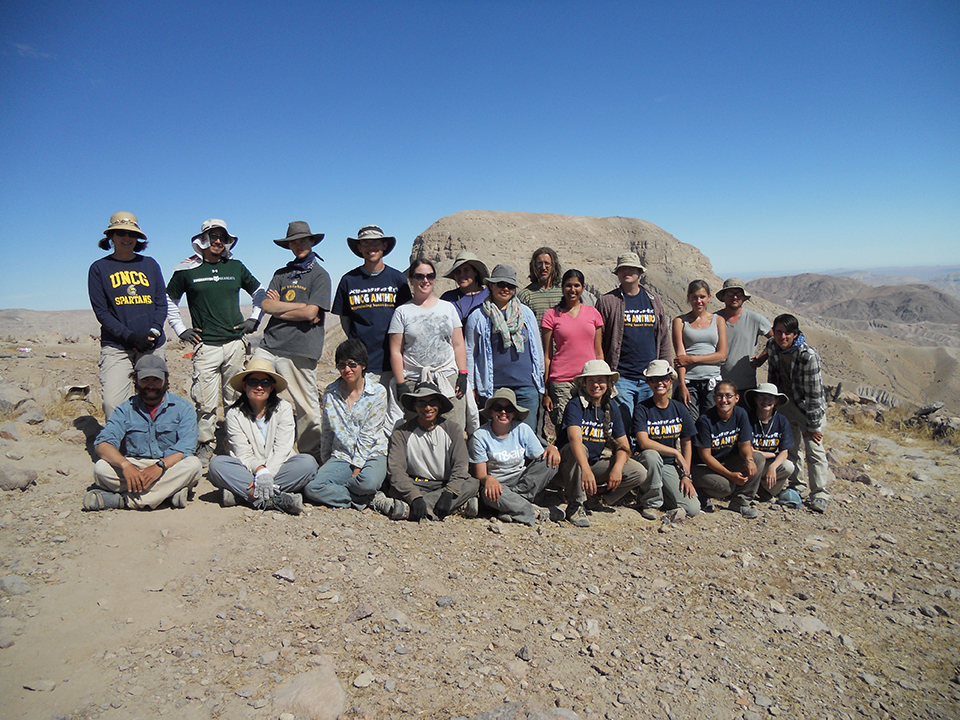
The field crew pose on the last day of excavations with a view of Cerro Baúl in the background. The 2011 field season crew (from top left to bottom left): Dr. Donna Nash, Edward Zegarra (TA), Iain Williams, Joshua Wackett (UNCG), Erin McAdams (UIC), Emily Schach (TA), Aracely Ambriz (UIC), Adrian Zabek (UIC), Navya Sampson (UIC), Alex Clute (UNCG), Alexis Ochalla (UIC), Matthew Biwer (TA), Erick Eckberg, Megan Allen (UNCG), Jenn Grenier (UNCG), Kristen Welch (UNCG), Emma Thomas (UNCG), Kate Scott (Illinois Wesleyan University), John Capua (UIC), Carolina Bernal (UIC), Emily Baca (TA), and David Reid (TA).
¡Adios, Amigos!
On the eve of the students’ departure, a despedida (a traditional Peruvian farewell party) was held in their honor and they were sent off in style on the morning of July 22. They rode in a combi back to Arequipa, in the same fashion that they arrived. After spending 5 weeks in Peru, the students boarded their planes to the States with a new awareness of Peruvian culture and a growing competence as future archaeologists. ¡Salud!